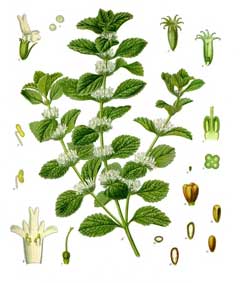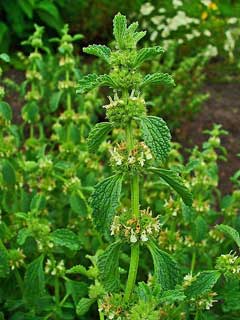 |
|
http://commons.wikimedia.org/wiki/File:Koeh-224.jpg |
 |
| http://commons.wikimedia.org/wiki/User:Llez |
Translate this page:
Summary
Physical Characteristics

 Marrubium vulgare is a PERENNIAL growing to 0.5 m (1ft 8in) by 0.5 m (1ft 8in).
Marrubium vulgare is a PERENNIAL growing to 0.5 m (1ft 8in) by 0.5 m (1ft 8in).
See above for USDA hardiness. It is hardy to UK zone 3 and is not frost tender. It is in flower from June to November, and the seeds ripen from August to October. The species is hermaphrodite (has both male and female organs) and is pollinated by Bees. The plant is self-fertile.
It is noted for attracting wildlife.
Suitable for: light (sandy), medium (loamy) and heavy (clay) soils, prefers well-drained soil and can grow in nutritionally poor soil. Suitable pH: mildly acid, neutral and basic (mildly alkaline) soils. It cannot grow in the shade. It prefers dry or moist soil.
UK Hardiness Map
US Hardiness Map
Synonyms
Marrubium apulum. Marrubium ballotoides. Marrubium germanicum. Marrubium uncinatum.
Plant Habitats
Cultivated Beds;
Edible Uses
Edible Parts:
Edible Uses: Condiment Tea
The leaves are used as a seasoning[27]. Bitter and pungent, they are sometimes used to flavour herb beer or liqueurs[4, 183]. Horehound ale is a fairly well-known drink made from the leaves[4, 238]. A mild pleasantly flavoured tea is made from the fresh or dried leaves[183], it is a favourite cough remedy[4, 46].
References More on Edible Uses
Medicinal Uses
Plants For A Future can not take any responsibility for any adverse effects from the use of plants. Always seek advice from a professional before using a plant medicinally.
Antidiarrhoeal Antidote Antiflatulent Antiseptic Antispasmodic Appetizer Cholagogue Diaphoretic
Digestive Diuretic Emmenagogue Expectorant Hepatic Stimulant TB
Tonic
White horehound is a well-known and popular herbal medicine that is often used as a domestic remedy for coughs, colds, wheeziness etc[4, 254]. The herb apparently causes the secretion of a more fluid mucous, readily cleared by coughing[254]. The leaves and young flowering stems are antiseptic, antispasmodic, cholagogue, diaphoretic, digestive, diuretic, emmenagogue, strongly expectorant, hepatic, stimulant and tonic[4, 7, 9, 21, 165, 238]. Horehound is a very valuable pectoral, expectorant and tonic that can be safely used by children as well as adults[4]. It is often made into a syrup or candy in order to disguise its very bitter flavour, though it can also be taken as a tea[4]. As a bitter tonic, it increases the appetite and supports the function of the stomach[254]. It can also act to normalize heart rhythm[254]. The plant is harvested as it comes into flower and can be used fresh or dried[238]. The root is a remedy for the bite of rattlesnakes, it is used in equal portions with Plantago lanceolata or P. major[207]. The German Commission E Monographs, a therapeutic guide to herbal medicine, approve Marrubium vulgare for dyspepsia, loss of appetite (see [302] for critics of commission E).
References More on Medicinal Uses
The Bookshop: Edible Plant Books
Our Latest books on Perennial Plants For Food Forests and Permaculture Gardens in paperback or digital formats.

Edible Tropical Plants
Food Forest Plants for Hotter Conditions: 250+ Plants For Tropical Food Forests & Permaculture Gardens.
More

Edible Temperate Plants
Plants for Your Food Forest: 500 Plants for Temperate Food Forests & Permaculture Gardens.
More

More Books
PFAF have eight books available in paperback and digital formats. Browse the shop for more information.
Shop Now
Other Uses
Companion Essential Repellent
An essential oil is obtained from the plant and used as a flavouring in liqueurs[46]. The plant has been used as a cure for cankerworm in trees[238]. No more details are given but it is probably a strong infusion of the flowering shoots, or the essential oil, that is used[K]. The growing plant repels flies[201].
Special Uses
Attracts Wildlife Food Forest Scented Plants
References More on Other Uses
Cultivation details
White horehound is an easily grown plant that succeeds in most well-drained soils[200], though it flourishes best in a poor dry soil[1, 4]. Another report says that the plant flourishes best where there is plenty of nitrogen in the soil[274]. It prefers neutral to alkaline soil conditions[238] and requires a warm sunny position if it is to do well[14]. Often grown in the herb garden and sometimes cultivated commercially as a medicinal herb[4, 61]. If the plant is cut back after flowering it will normally produce a second crop of leaves[238]. The fresh leaves have a pronounced musky smell, though this is lost once the plant is dried[245]. A good bee plant[1]. White horehound is a good companion plant for growing near tomatoes[24]. The tomatoes crop for a longer period and also produce a heavier crop[201]. In garden design, as well as the above-ground architecture of a plant, root structure considerations help in choosing plants that work together for their optimal soil requirements including nutrients and water. The root pattern is rhizomatous with underground stems sending roots and shoots along their length [2-1].
References Carbon Farming Information and Carbon Sequestration Information
Temperature Converter
Type a value in the Celsius field to convert the value to Fahrenheit:
Fahrenheit:
The PFAF Bookshop
Plants For A Future have a number of books available in paperback and digital form. Book titles include Edible Plants, Edible Perennials, Edible Trees,Edible Shrubs, Woodland Gardening, and Temperate Food Forest Plants. Our new book is Food Forest Plants For Hotter Conditions (Tropical and Sub-Tropical).
Shop Now
Plant Propagation
Seed - sow April/May or August/September in a cold frame. Germination can be slow and erratic[200]. Prick out the seedlings into individual pots when they are large enough to handle and plant them out in the following spring[K]. Basal cuttings in late spring. Harvest the shoots with plenty of underground stem when they are about 8 - 10cm above the ground. Pot them up into individual pots and keep them in light shade in a cold frame or greenhouse until they are rooting well. Plant them out in the summer. Division in spring[1]. Larger clumps can be replanted direct into their permanent positions, though it is best to pot up smaller clumps and grow them on in a cold frame until they are rooting well. Plant them out in the spring.
Other Names
If available other names are mentioned here
White Horehound, Horehound, Common horehound
Native Range
TEMPERATE ASIA: Afghanistan, Cyprus, Iran, Israel, Jordan, Lebanon, Syria, Turkey, Russian Federation-Ciscaucasia (Ciscaucasia), Armenia, Azerbaijan, Kazakhstan, Turkmenistan, Uzbekistan, China (Xinjiang Uygur Zizhiqu) TROPICAL ASIA: Pakistan (north) EUROPE: Denmark, United Kingdom (England), Sweden (south), Czechoslovakia, Austria, Belgium, Switzerland, Hungary, Netherlands, Poland, Russian Federation-European part (European part (southwest)), Belarus, Estonia, Lithuania, Latvia, Ukraine (incl. Krym), Former Yugoslavia, Albania, Bulgaria, Greece (incl. Crete), Italy (incl. Sardinia, Sicily), Romania, Spain (incl. Baleares), France (incl. Corsica), Portugal AFRICA: Spain (Canarias), Portugal (Madeira Islands), Algeria (north), Libya (north), Morocco, Tunisia
Weed Potential
Right plant wrong place. We are currently updating this section.
Please note that a plant may be invasive in one area but may not in your area so it's worth checking.
Conservation Status
IUCN Red List of Threatened Plants Status :

Growth: S = slow M = medium F = fast. Soil: L = light (sandy) M = medium H = heavy (clay). pH: A = acid N = neutral B = basic (alkaline). Shade: F = full shade S = semi-shade N = no shade. Moisture: D = dry M = Moist We = wet Wa = water.
Now available:
Food Forest Plants for Mediterranean Conditions
350+ Perennial Plants For Mediterranean and Drier Food Forests and Permaculture Gardens.
[Paperback and eBook]
This is the third in Plants For A Future's series of plant guides for food forests tailored to
specific climate zones. Following volumes on temperate and tropical ecosystems, this book focuses
on species suited to Mediterranean conditions—regions with hot, dry summers and cool, wet winters,
often facing the added challenge of climate change.
Read More
Expert comment
Author
L.
Botanical References
17200
Links / References
For a list of references used on this page please go here
Readers comment
| Add a comment |
|
If you have important information about this plant that may help other users please add a comment or link below. Only comments or links that are felt to be directly relevant to a plant will be included. If you think a comment/link or information contained on this page is inaccurate or misleading we would welcome your feedback at [email protected]. If you have questions about a plant please use the Forum on this website as we do not have the resources to answer questions ourselves.
* Please note: the comments by website users are not necessarily those held by PFAF and may give misleading or inaccurate information.
To leave a comment please Register or login here All comments need to be approved so will not appear immediately.
|
Subject : Marrubium vulgare
|
|
|
|